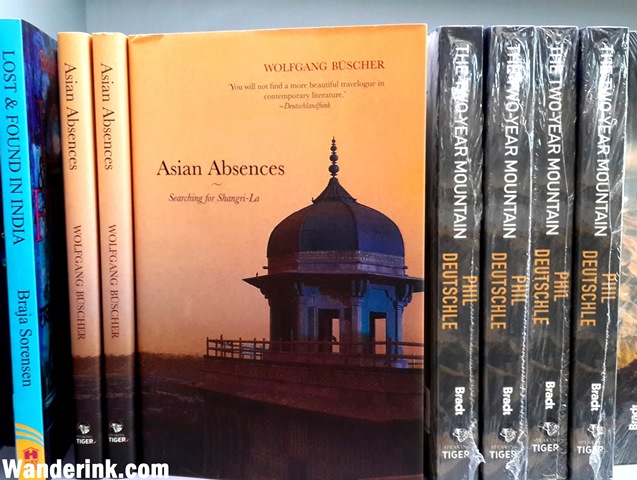Every travel is a quest for Shangri-La – the mystical, mythical land of harmonious coexistence, contentment and fulfilment. With a subtitle like ‘Searching for Shangri-La’ travel, thus, has to go on. But when the last in the collection of (just) six travelogues that make up Asian Absences is called ‘Shangri-La’ it almost seems like the insatiable hunt has come to an end. This ‘hour at the edge of the clearing’ leaves several jolts in its wake which possibly is the intention. For this Shangri-La is the China-made model Tibet awaiting tourists with even a Sexy Yeti bar, a ‘No Problem Tibet.’ The moment continues, as an ‘elusive prey.’ Asian Absences is brimming with such moments that evokes and mocks, acknowledges and aggravates wonders. Spanning India, Singapore, Cambodia, Japan and Nepal, the quest is feverish and the language lyrical; much is owed to translator Simon Pare – metaphors and cultural icons do not lurk about unseemly and uncomprehendingly nor do they lurch out whoa but have been handled with a sensitive deftness probably an outcome of his own fascination with Asia.
The opening piece ‘An Indian Afternoon’ is a literally pyretic prose where Buscher drifts between a beleaguered present in Jodhpur and a hallucinatory fever, a frequent occurrence perhaps, during his boyhood. The cacophonous urgency mingles with insightful observations we are all too familiar with: the sacred cow’s ‘languor a provocation’ and the ‘doll-sized temples’ beneath roadside trees that look ‘abandoned after a children’s game.’ The high point of the narrative is the poetic quality of the prose: Buscher can mean a lot without saying a lot. ‘Spotting the god in the gutter’ had me scrambling for a pencil. It is not shorn of the usual traveller wonders either – there is a maharaja who does a sitar recital with monkeys in attendance and a spiritual guru studiously soliciting the author’s discipleship with sumptuous pure ghee food.
What makes travel writing truly memorable is when the writer goes beyond the landscape and things he has seen and dwells profoundly into thought and feelings. Buscher does this a lot and hearteningly these digressions are not socio, economic or political in nature albeit a wry dream sequence in ‘Mekong Mama’ where Condoleezza Rice is the leader of a pack of ants who never begrudged her right to first bite of the pizza. No statistics are enumerated to prove a point and there is a much-needed break from paronomasia, however playful, as most popular travel writers seem to be bent upon these days. From the dark and dank days in Jodhpur, the brooding veil is lifted for a whiff of fresh air in ‘The Cricketer’ where we are introduced to St John, second officer of an oil tanker aboard which the writer hitches a ride to Singapore, who gads about with a cricket bat playing air shots. Like most travel writers Buscher too has an eye for minor details but what makes him special is he revels – and dazzles – in these. The darkest hour in the morning ‘when nothing more appears and everything crawls into itself’ (Mekong Mama) is just one of the many the book is littered with. Pencil.
Of the (just six, I repeat) travelogues, I enjoyed most ‘Among Shamans’ not because it was the longest but also because I too have trekked in Tibet and spent time among shamans while filming a travel series. I could absolutely relate to the ‘inhuman solitude of the high mountains of Central Asia.’ I have also ‘shrank into my breath’ while the ‘world went black and red before my eyes.’ While the appearance of Shiva himself in his dreams could have been a Third Man phenomenon, my brushes weren’t so benign. Buscher was also luckier for he experienced a trance, first-hand, with the ‘slowly, slowly widening distance to the noise around’ and falls in love with a woman shaman. He doesn’t linger much on the ‘Shiva Airways’ bit but then it is anybody’s guess. ‘The God of Roppongi’ is a eulogy to the wondrous Tokyo, an ongoing creation, a stopover version of the Pico Iyer classic ‘The Lady and the Monk.’ With ‘Shangri-La’ and its expectedly drastic revelations, not just our pining but our purpose itself to travel is left intact – to find Shangri-La.
At just six chapters over 147 pages, Asian Absences is like a dainty dessert – you want to nibble at it to make it last at the same time gobble it all up in one go.
This review first appeared in The New Indian Express; Wolfgang Buscher’s photograph is courtesy of publisher website, Speaking Tree; translator Simon Pare from Banipal.














